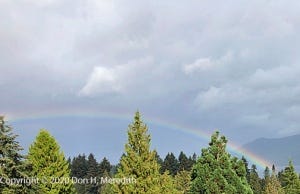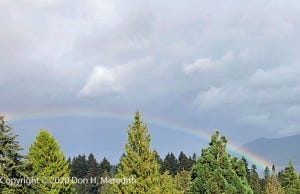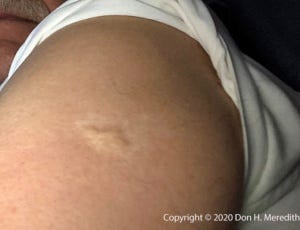Waiting for the Miracle
or
Thoughts on Viruses, Vaccines and Hope
The sands of time were falling
From your fingers and your thumb
And you were waiting
For the miracle, for the miracle to come
-Leonard Cohen, Waiting for the Miracle
You will note that I have not posted to this blog in a long time. Like most of you, I’ve been trying to sort out just what we’re facing with this pandemic and how to cope. Whenever I sat down to write a piece, other issues intervened. As well, it became obvious to our immediate family that being distantly isolated from one another at this time of great uncertainty was not helpful. So, we’ve moved ourselves and resources under one roof, where we can look after each other and share expenses. That’s a lot easier said than done. Once the house sale and purchase were completed, we had our work cut out for us. More on that in a later post.
Right now, I’d like to discuss the hope we all have that a vaccine will be found and we will be out from under this pandemic soon and return to something akin to what we considered “normal” before March 2020. In a sense, we are “waiting for the miracle” in Leonard Cohen’s song. It’s good to have hope, we all need it to maintain our mental health; but it’s also important to understand the reality of the issue we face, and why waiting might take longer than we hope.
Viruses
As a biologist, I find viruses to be quite interesting. For an extremely small entity (about 1/1000 the width of a human hair), they have an immense impact on our ecosystems and health. Essentially, they are just packets of genetic material (RNA) that require a living cell to get their energy and reproduce. It turns out viruses are everywhere: in soil, water, air and on surfaces. They fall from the sky every day, and if you’ve been outside, they’ve fallen on you and are in the air you breathe.
Don’t be alarmed! The vast majority are harmless to humans, and our immune systems readily handle them. The ones the jet stream distributes around the world are soil or marine viruses that need to infect bacteria and other small organisms to reproduce. Indeed, most provide valuable ecosystem services, such as keeping bacterial populations balanced.
Other viruses cause diseases in plants and animals. Again, most are harmless to humans; but the few that infect us can be quite debilitating and lethal. The common cold and influenza (flu) are the most common maladies we suffer from viruses. But as demonstrated by the necessity to take a flu vaccine every year, viruses are constantly evolving and seeking new hosts.
Pandemics, Epidemics and Vaccines
Until Covid-19 came along, most people alive today had not experienced a pandemic, where the entire world is affected (SARS, bird and swine flu were epidemics, affecting only certain regions of the world). The last one we had was the 1918 Spanish Flu that infected 500 million people (~30% of the total human population of 1.7 billion) and killed 50 million (~3%). My parents were small children during that time but they remembered the concern of their parents. Of course, in those days, there was no internet, social media or TV, and commercial radio was still a couple of years away. So, people depended on newspapers for their news. Antibiotics, vaccines and painkillers were few. Because my parents lived in rural areas, the chance of infection was reduced and they were not directly affected, but the threat remained.
When I arrived at the end of World War II, my parents were very concerned with my health because they had had a rough ride with my older brother, who had survived some medical issues because of our parents’ perseverance in getting him the help he needed. So, when I came along, they ensured I had every opportunity to keep my health.
Smallpox
The first vaccination I had was for smallpox (variola virus), a vaccine first created in the 19th century. Smallpox was a highly infectious and lethal disease that had plagued humanity for millennia. I don’t remember receiving the vaccination because I was about two-years old at the time, but I was told I screamed a lot. Unlike a simple injection under the skin or into muscle, the smallpox vaccine was injected by repeated stabbings into the skin at the same site. To this day, I have a thick round scar on my upper left arm from that first injection—sort of an identification badge for my generation.
A booster vaccination for smallpox was also required. I don’t remember much about that injection either, being 5 or 6 years old, but I imagine it wasn’t pleasant as it still required multiple stabbings into the lower levels of the skin, although the technique had been refined (a multiple needle device). The booster was delivered to my upper right arm and left a much smaller scar that is not visible today.
As a result of world-wide vaccinations, smallpox was eradicated around the world in 1977. The virus doesn’t exist outside samples stored at research labs. Eradication is the goal of any vaccination program but it has only occurred with smallpox, as the result of a concerted effort by health organizations throughout the world.
Polio
Another disease that concerned my parents was Poliomyelitis, or polio for short. It’s a debilitating disease that primarily strikes children but also adults. Death rates in children could be as high as 5% but in adults as high as 30%. It is also caused by a virus (poliovirus). The virus attacks muscles, often in the legs, causing them to weaken and the victim not being able to walk or walk awkwardly. It may also strike other muscles including the diaphragm, making it difficult to breathe and often resulting in death. Many people survived the disease with no long-lasting ill effects, but others were not so lucky and had permanent disabilities.
As a boy, I remember attending our church’s Sunday school with a kid in a wheelchair who had survived polio but it left him disabled, unable to move his legs. Some others who survived had to spend the remainder of their lives in an iron lung that breathed for them. So, it’s not hard to understand why parents were concerned.
By the 1950s there had been several polio epidemics in North America, starting in the late 19th century, and affecting particular cities or regions. Because not a lot was known about how the disease spread, local governments where infections occurred closed down theatres, swimming pools and banned social gatherings. Parents kept their children at home. Sound familiar?
It was later determined that the virus spread through food or water contaminated with fecal matter. So, any infected person with poor hygiene habits could spread it. Like Covid-19, you could have polio and not show symptoms.
There were several attempts at developing a vaccine for polio since the 1930s but most were ineffective or indeed dangerous. Then in 1954 Dr. Jonas Salk at the University of Pittsburgh developed an effective vaccine using inactive polio virus. It was a major breakthrough but problems occurred during commercial production when some companies failed to completely inactivate the virus, among other issues, and some people caught the disease from the vaccine. The process was refined and finally by 1955 enough effectual vaccine was developed to immunize grade school students.
I remember my mother marching me down to the high school I would attend a few years later to stand in line with other mothers and their children, waiting to get the Salk vaccine. I believe having the vaccination was a requirement to attend a public school. The result was polio infections quickly dropped off and the fear among parents abated. Then in 1958 the number of cases increased significantly among those who had not taken the vaccine, and fear rose again.
In 1961 an oral vaccine was developed by Albert Sabin and it was recommended that all children take the new vaccine as a booster. I remember receiving the vaccine on a sugar cube at the school I attended at the time. No needle pricks or stabbings, and as a result many more people, especially children, took the vaccine. By 1979, the disease was largely eradicated from North America but it is still extant in some third-world countries.
Post-polio Syndrome. Many people who had recovered from polio started experiencing polio symptoms again 30 or 40 years later, including muscle weakness, general fatigue, muscle atrophy and breathing and swallowing problems. It turns out these symptoms are not a return of the virus (as happens with the chicken pox/shingles virus) but a result of the damage the virus did those many years ago.
Herd Immunity
The biggest requirement involved with eradicating a virus is achieving so called “herd immunity”, where 60 to 80% of the population has sufficient antibodies against the virus to prevent infection (or reinfection) and further spread of the virus. In other words, enough people are immune that the virus has difficulty finding a suitable host, to the point that it eventually dies out.
Herd immunity is accomplished in two ways: 1) a sufficient number of people are exposed to the virus, survive the infection and develop antibodies as a result, preventing further infection, 2) a vaccine is developed and administered to a sufficient number of people and produces the necessary antibodies in those people to resist infection. Or a combination of the two. To prevent as many deaths as possible from Covid-19, developing a vaccine is the obvious answer to increasing herd immunity. And indeed, that’s what laboratories around the world are working on. As I write, some vaccines are in clinical trials. This is good news, and demonstrates what can happen when the collective will and energy of the world is mobilized to solve a crisis. (I know, I know: think what could happen if such will and energy were mobilized for the climate crisis? But I digress.)
However, this process does take time. Successful vaccines in the past have taken four to five years (if not decades) to research, develop and get on the market. This time around, the research and development have been streamlined, but there is a danger that shortcuts will be made. As the early polio virus trials showed, when a vaccine is rushed, mistakes are made. Clinic trials are where errors can be found without risking the health of vulnerable portions of the population.
Of course, the Cockwomble down south doesn’t think this pandemic is a problem and believes that most people should live their lives as they did before it struck. And when you contract the disease, just fight the infection and become immune as a result. Of course, such advice ignores the realities of the death and disability that this disease causes. It’s NOT just another flu, as confirmed by the high death toll our southern neighbour is experiencing.
Also, it’s very possible that some vaccines might not provide sufficient long-lasting protection, or only protect a portion of the population. In other words, it might take a while to achieve herd immunity if it’s ever achieved at all.
Pandemic Fatigue
What is becoming obvious is this virus is going to be with us for a long time, and we’re going to have to cope with it. That means life as we knew it prior to 2020 will not return. That said, some sense of normality is necessary just to cope. As I write this, it’s been nine months since the coronavirus first appeared. During that time, we’ve had to self-isolate and only converse at a distance or over the internet with our neighbours, friends and relatives. Many businesses had to close for a time, some never to reopen.
Economies cannot be shutdown indefinitely. People need food, services and employment. So, it’s inevitable that once most people understood what was required to prevent spread of the disease, restrictions would be relaxed to allow commerce to resume, conditionally. This worked for most people but there are always those who don’t like being told what to do even if it’s for the good of all. They complain about their freedom being restricted, etc. and choose to ignore the science. These people are the reason we are having a second and possibly third wave of infection.
All that said, coping with the pandemic does get tiring. I used to enjoy taking a break and going to town to do some shopping and maybe meet with friends or colleagues for coffee or lunch. Now, that’s become a chore because we must physically distance and wear masks if we wish to comply with the pandemic protocols. It is indeed nice to see other people but the masks are uncomfortable and form barriers that block more than just the virus.
However, if we want to stay healthy, we must comply with the public health protocols, not only for our own safety but for that of the vulnerable portions of the population, such as seniors and those with additional health issues. The bottom line is we will get through this. But we must do it together so we all can have hope and hasten “the miracle to come.”
Comments are always welcome (below).
Visit me on my website where you’ll find more stories and pics:
www.donmeredith.ca
Interested in reading an award-winning outdoor adventure novel? Check out The Search for Grizzly One and Dog Runner.





